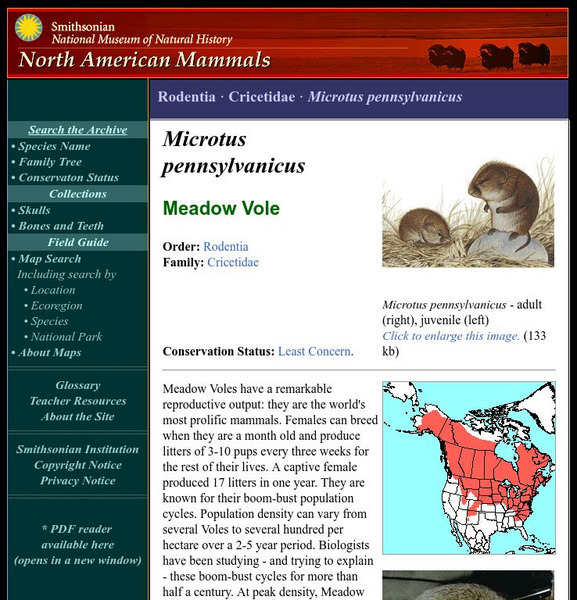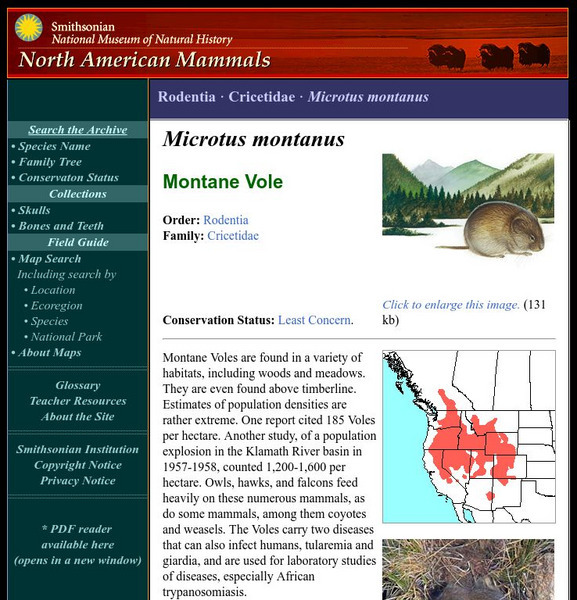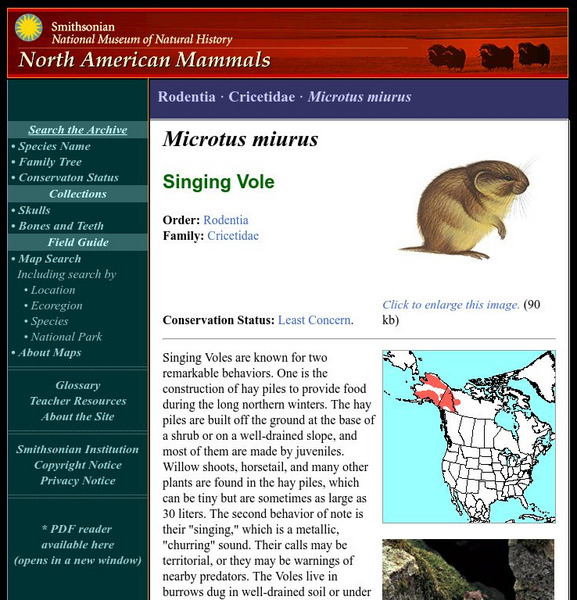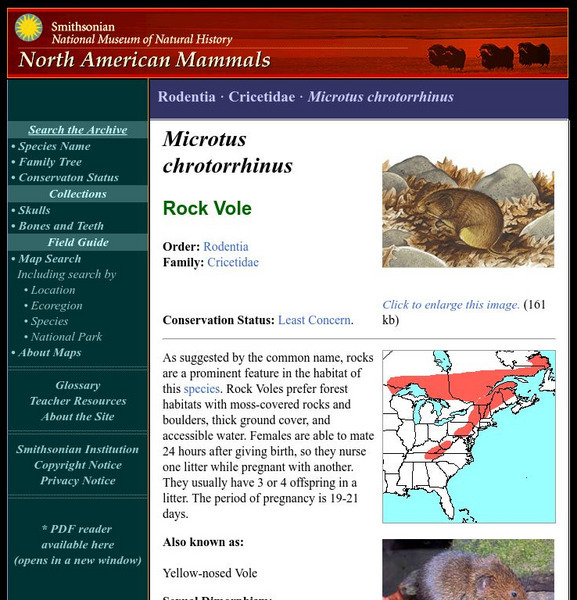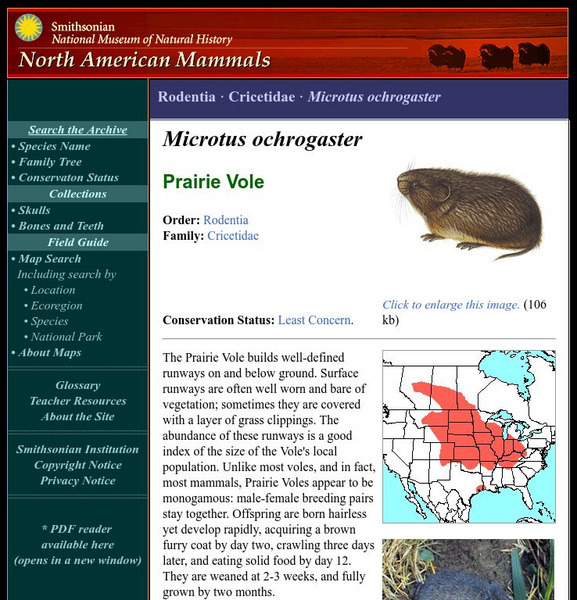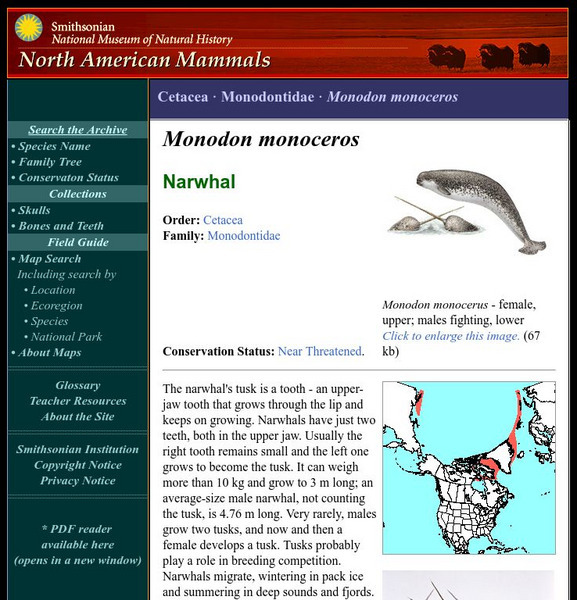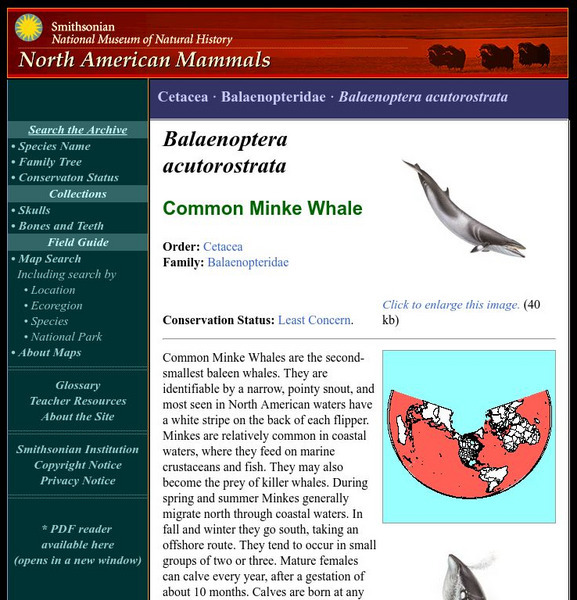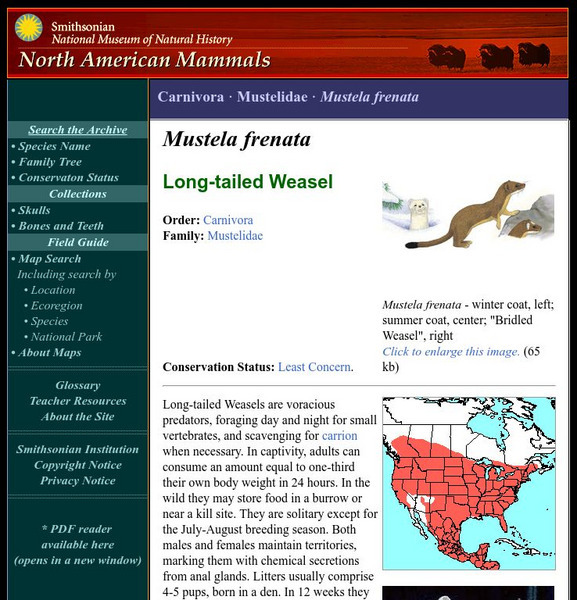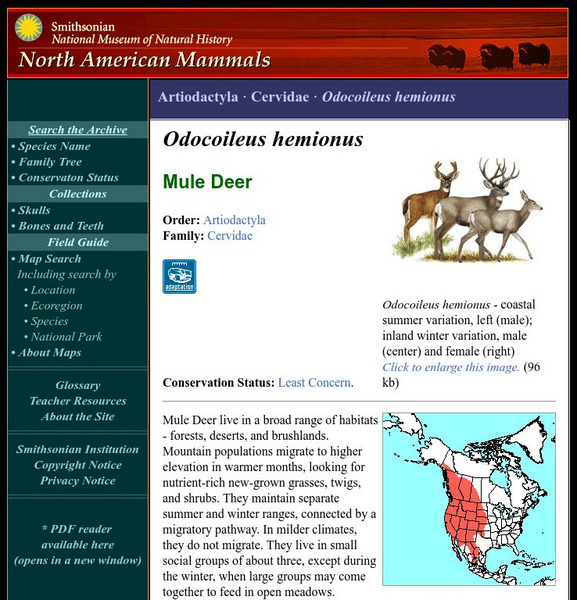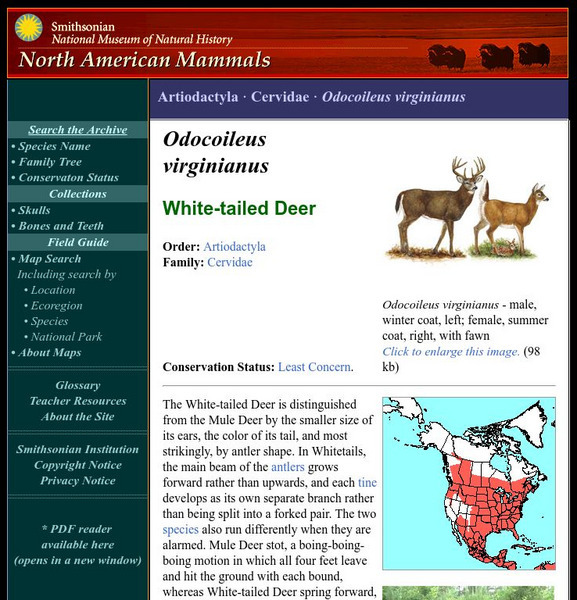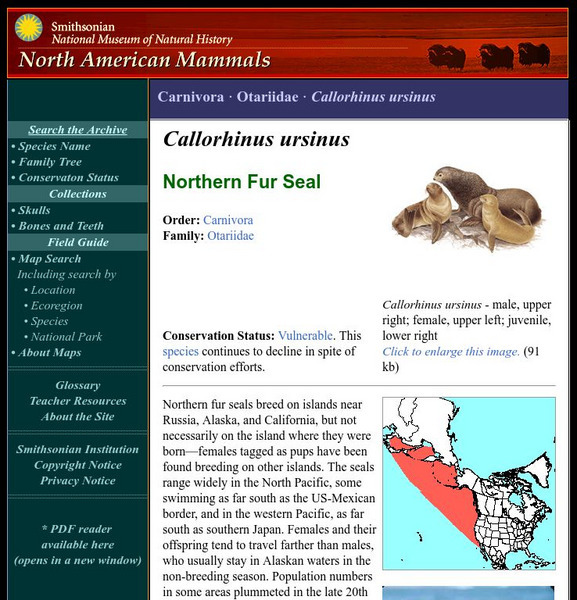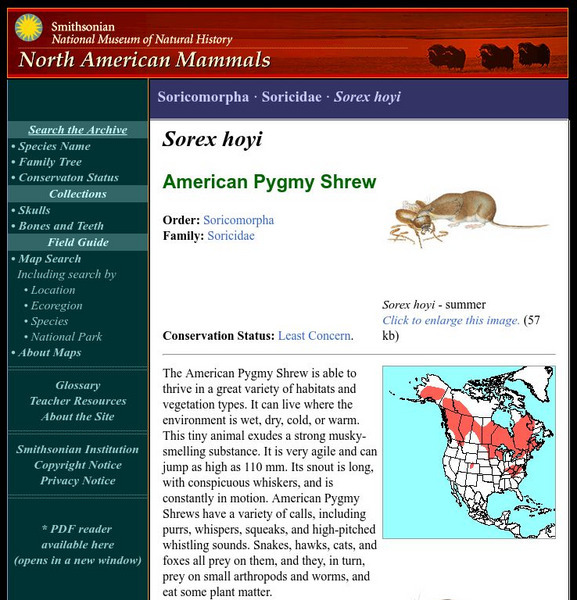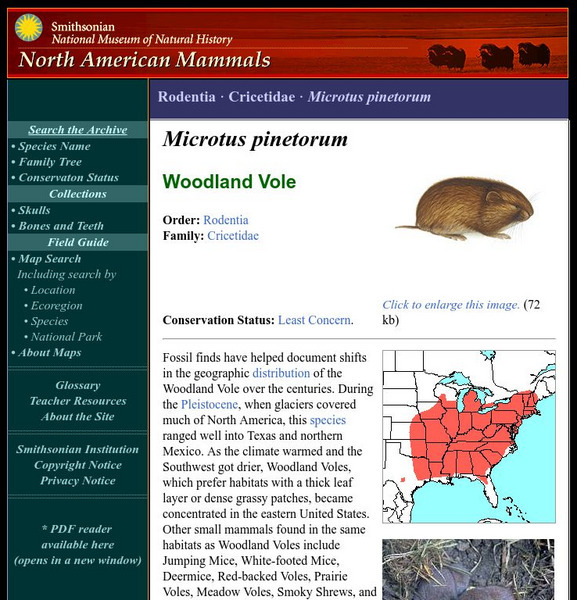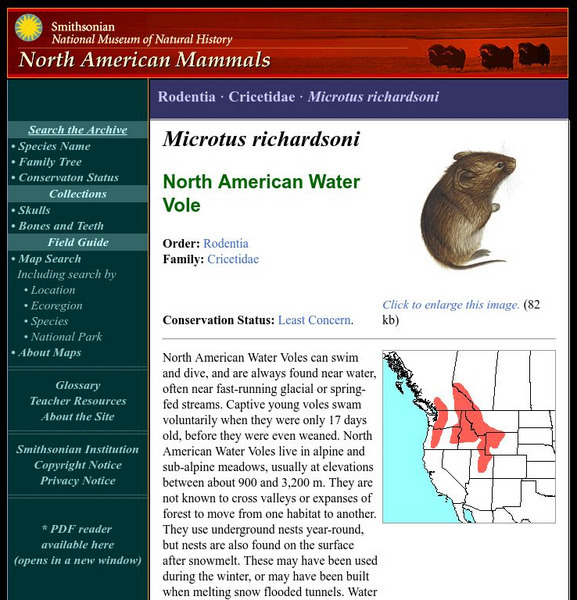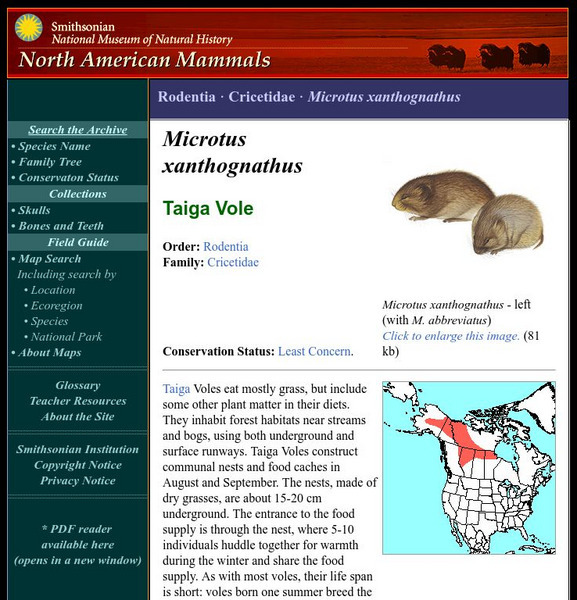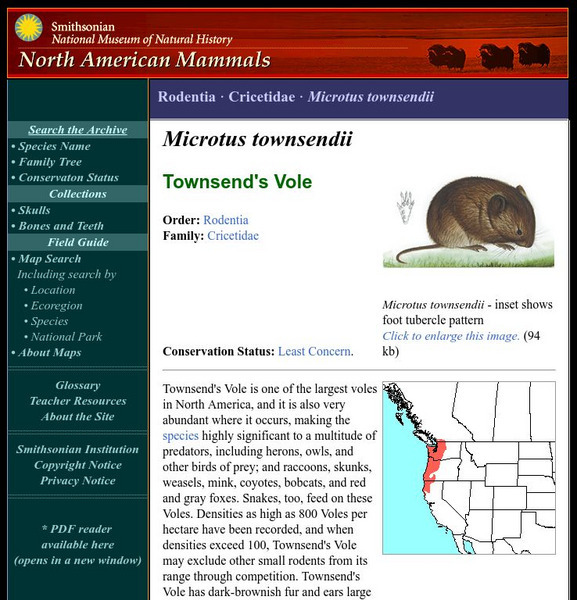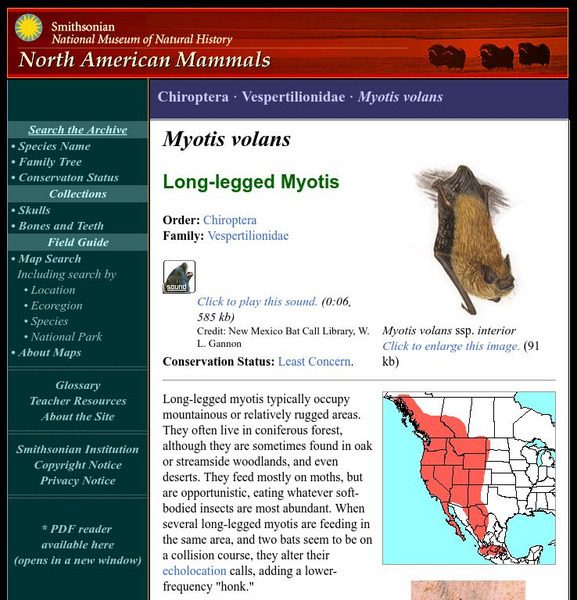Smithsonian Institution
National Museum of Natural History: American Mammals: Stejneger's Beaked Whale
Thirty-one of the 48 sightings of Stejneger's beaked whale have come from Alaskan waters. It is suspected this species favors deep waters, including the Aleutian Trench and the Aleutian Basin, which is some 3,500 m deep, rather than the...
Smithsonian Institution
National Museum of Natural History: American Mammals: Meadow Vole
Meadow Voles have a remarkable reproductive output: they are the world's most prolific mammals. Females can breed when they are a month old and produce litters of 3-10 pups every three weeks for the rest of their lives. Learn more about...
Smithsonian Institution
National Museum of Natural History: American Mammals: Tundra Vole
Tundra Voles have the northernmost distribution of any North American species of Microtus. They are widespread in northern latitudes in Eurasia, too, where they are known as Root Voles, and probably migrated to North America across the...
Smithsonian Institution
National Museum of Natural History: American Mammals: Montane Vole
Montane Voles are found in a variety of habitats, including woods and meadows. They are even found above timberline. Learn more about the Microtus montanus, more commonly known as a Montane Vole, in this easy-to-read species overview by...
Smithsonian Institution
National Museum of Natural History: American Mammals: Singing Vole
Singing Voles are known for two remarkable behaviors. One is the construction of hay piles to provide food during the long northern winters. Learn more about the Microtus miurus, more commonly known as a Singing Vole, in this...
Smithsonian Institution
National Museum of Natural History: American Mammals: Rock Vole
As suggested by the common name, rocks are a prominent feature in the habitat of this species. Rock Voles prefer forest habitats with moss-covered rocks and boulders, thick ground cover, and accessible water. Learn more about the...
Smithsonian Institution
National Museum of Natural History: American Mammals: Long Tailed Vole
Long-tailed Voles need cool, moist habitats, so they are found mostly near the peaks of mountain ranges. Fruits and seeds make up the bulk of their diet, but they also eat fungi, bark, and leaves if necessary. Learn more about the...
Smithsonian Institution
National Museum of Natural History: American Mammals: Prairie Vole
The Prairie Vole builds well-defined runways on and below ground. Surface runways are often well worn and bare of vegetation; sometimes they are covered with a layer of grass clippings. Learn more about the Microtus ochrogaster, more...
Smithsonian Institution
National Museum of Natural History: American Mammals: Narwhal
The narwhal's tusk is a tooth - an upper-jaw tooth that grows through the lip and keeps on growing. Narwhals have just two teeth, both in the upper jaw. Learn more about the Monodon monocerus, more commonly known as a Narwhal, in this...
Smithsonian Institution
National Museum of Natural History: American Mammals: Common Minke Whale
Common Minke Whales are the second-smallest baleen whales. They are identifiable by a narrow, pointy snout, and most seen in North American waters have a white stripe on the back of each flipper. Learn more about the Balaenoptera...
Smithsonian Institution
National Museum of Natural History: American Mammals: Long Tailed Weasel
Long-tailed Weasels are voracious predators, foraging day and night for small vertebrates, and scavenging for carrion when necessary. In captivity, adults can consume an amount equal to one-third their own body weight in 24 hours. Learn...
Smithsonian Institution
National Museum of Natural History: American Mammals: Mule Deer
Mule Deer live in a broad range of habitats - forests, deserts, and brushlands. Mountain populations migrate to higher elevation in warmer months, looking for nutrient-rich new-grown grasses, twigs, and shrubs. Learn more about the...
Smithsonian Institution
National Museum of Natural History: American Mammals: White Tailed Deer
The White-tailed Deer is distinguished from the Mule Deer by the smaller size of its ears, the color of its tail, and most strikingly, by antler shape. In Whitetails, the main beam of the antlers grows forward rather than upwards, and...
Smithsonian Institution
National Museum of Natural History: American Mammals: Northern Fur Seal
Northern fur seals breed on islands near Russia, Alaska, and California, but not necessarily on the island where they were born females tagged as pups have been found breeding on other islands. The seals range widely in the North...
Smithsonian Institution
National Museum of Natural History: American Mammals: Sperm Whale
Sperm whales can dive deeper than 1.6 km and stay under for 90 minutes, although shorter, shallower dives are more usual. Learn more about the Physeter catodon (Physeter macrocephalus), more commonly known as a Sperm Whale, in this...
Smithsonian Institution
National Museum of Natural History: American Mammals: American Pygmy Shrew
The American Pygmy Shrew is able to thrive in a great variety of habitats and vegetation types. It can live where the environment is wet, dry, cold, or warm. Learn more about the Sorex hoyi, more commonly known as a Pygmy Shrew, in this...
Smithsonian Institution
National Museum of Natural History: American Mammals: Woodland Vole
Fossil finds have helped document shifts in the geographic distribution of the Woodland Vole over the centuries. During the Pleistocene, when glaciers covered much of North America, this species ranged well into Texas and northern...
Smithsonian Institution
National Museum of Natural History: American Mammals: North American Water Vole
North American Water Voles can swim and dive, and are always found near water, often near fast-running glacial or spring-fed streams. Captive young Voles swam voluntarily when they were only 17 days old, before they were even weaned....
Smithsonian Institution
National Museum of Natural History: American Mammals: Taiga Vole
Taiga Voles eat mostly grass, but include some other plant matter in their diets. They inhabit forest habitats near streams and bogs, using both underground and surface runways. Learn more about the Microtus xanthognathus, more commonly...
Smithsonian Institution
National Museum of Natural History: American Mammals: Townsend's Vole
Townsend's Vole is one of the largest voles in North America, and it is also very abundant where it occurs, making the species highly significant to a multitude of predators, including herons, owls, and other birds of prey; and raccoons,...
Smithsonian Institution
National Museum of Natural History: American Mammals: Northern Elephant Seal
As is often the case in species where males compete to mate with as many females as possible, northern elephant seal males are much larger than females (1,800 kg versus 650 kg on average). Competitions can be battles, but more often...
Smithsonian Institution
National Museum of Natural History: American Mammals: Southeastern Myotis
The southeastern myotis occurs as far west as northeastern Texas and southwestern Oklahoma. Its preferred daytime roosts are caves with pools of water. Learn more about the Myotis austroriparius, more commonly known as a Southeastern...
Smithsonian Institution
National Museum of Natural History: American Mammals: Long Legged Myotis
Long-legged myotis typically occupy mountainous or relatively rugged areas. They often live in coniferous forests, although they are sometimes found in oak or streamside woodlands, and even deserts. Learn more about the Myotis volans,...
Smithsonian Institution
National Museum of Natural History: American Mammals: Yuma Myotis
The skull and jaws of the Yuma myotis suggest a dependence on relatively soft insects, and the little dietary information available supports this. It fits well with the bat's habit of foraging over water, where moths and other...

